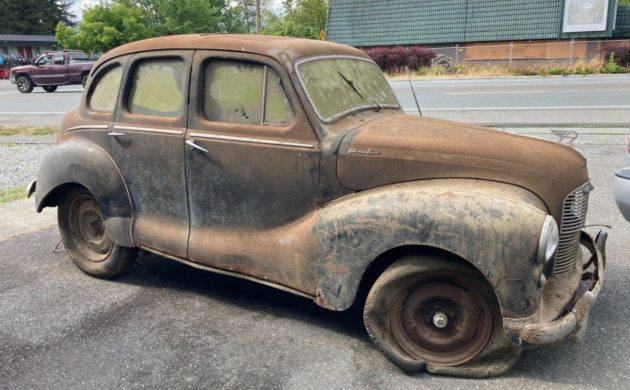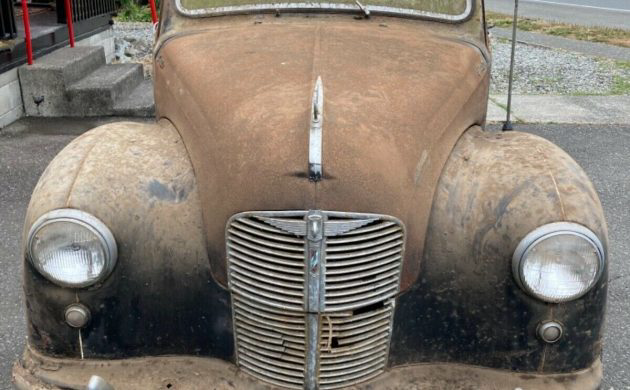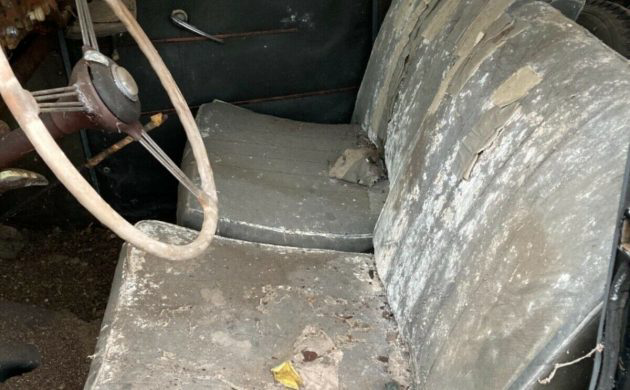Farm Find Project: 1950 Austin A40 Devon
The A40 was marketed by Austin Motor Co. between 1947-52. They were the first post-war cars the company built and had a mixture of both old and new engineering. More than 450,000 of them were built in six years and some number of them found their way to the U.S. This 1950 4-door sedan was retrieved from a farm where it has no doubt spent the last several years. From Sultan, Washington, this old British car is available here on eBay for $3,000 (Buy It Now).
Four-door versions of the A40 were called Devon’s, while the two-door models were known as Dorset’s. They were some of the last cars built before Austin merged with Morris Motors to become British Motor Corp. (BMC) in 1952. The little cars were powered by a 1.2-liter (1,200cc) inline-4 motor. The number of these cars that are left in the U.S. in any condition must be small, and the seller’s edition is set up for left-hand-drive, so it was an export model.
Despite its physical appearance, the seller believes this ’50 Devon’s body is mostly straight. Sure, there’s a little dent here and there and patina has taken over what was likely green paint when new. The glass is all in place and may to stuck in position. The seller has been unable to get the hood open, so we don’t know if the engine is complete. The key is gone, but the car has a valid title.
One unusual feature of the car is a metal sunroof, something you didn’t see much of in those days, and certainly not on inexpensively produced automobiles. To help bring the car back from the brink, the seller has some extra parts that may be of use and can provide photos of them on request. This will not be a project for the faint-hearted and some of what you’d need to restore the car may be hard or precious to find. Who wants to make this Austin roadworthy again?
Auctions Ending Soon
 2006 Ford Mustang Saleen S281 SCBid Now11 hours$15,000
2006 Ford Mustang Saleen S281 SCBid Now11 hours$15,000
 2002 Subaru Impreza WRXBid Now3 days$333
2002 Subaru Impreza WRXBid Now3 days$333
 1975 Chevrolet Corvette ConvertibleBid Now3 days$3,000
1975 Chevrolet Corvette ConvertibleBid Now3 days$3,000
 1964 Ford F-100 Camper CustomBid Now3 days$2,000
1964 Ford F-100 Camper CustomBid Now3 days$2,000
 2006 Jeep Wrangler SportBid Now5 days$10,500
2006 Jeep Wrangler SportBid Now5 days$10,500





Comments
Well, I haven’t owned a Devon but 3 of the 1953/54 A40 Somerset that followed and they are essentially the same car under the restyled skin. They’re quite strange cars, very British and feeling very old-fashioned. They drive more like something from the mid -30’s than from the 1950’s. I guess they were really designed for British countryside roads, but the gearing is incredibly low so already at 45 mph it’s screaming for mercy. On the other hand, it was probably a good thing that it wasn’t faster because steering, handling and brakes are clearly not designed for higher speeds either. You are really white-knuckling it when you start getting up to those speeds. As a hobby car they do have some advantages. Parts were cheap and rather easy to find, and overall they are very simple to work on. There’s nothing that’s complicated or hard to access. They also appear not very sensitive to rust, all of my cars were very solid and the steel felt quite heavy grade – at least compared to the Italian and French cars that I’ve had many of.
I can remember two incredibly British features, one was that the jacking points are accessed from holes in the floor from inside the car to protect you from the weather while jacking the car up. The other that despite being left hand drive cars the only external door lock is on the left front door. Totally puzzling!
As a final note, I believe that the sunroof was quite common on the Devon, possibly even standard equipment? At least all Devons that I have seen have had the sunroof.
The Somerset came at a point where Austin styling was deliberately going out of their way to avoid American and Italian influences. Since pretty much every auto-design influence of the early postwar years came from the Italian *carrozzeria* before being refined and adapted for mass-produced sedans by Detroit, the result was almost cartoonishly British.
met a guy once who put this body on a full frame 2D Kia Sportage full frame (’98-05’ish).
Good comments by @Beyfon. These were exported widely after WW2 because the world was starved of cars and most European factories had been destroyed.
So, having decided that the VW project was total garbage when offered to them, the Brits did what they do best and got confused between arrogance and cool judgement. These drove like pre-war cars, because basically they had advanced little. Noteworthy feature is the 1200cc motor is the first B seriies engine. The rest, not very good, though they made good gassers.
The Somerset which Beyfon mentions was shipped CKD to Datsun and kickstarted post war Japanese car industry. Ironic?
My parent’s first car. One I got to drive, as a small child, sitting on my Father’s lap.
They were quite common in Canada, due to preferential import duties on British made cars. There were several in our rural community.
Another quirky feature is the semaphore turn signals in the B pillar.
Not shown in these pictures, the crank start hole in the front bumper.
My Father had to crank start ours a couple of times, after I discharged the battery, while sitting in the car listening to the radio.
Shout out to my best friend Lyle, who got me a Flying A hood ornament from one this spring, all polished up and mounted on a wood base, as a desk ornament. Thanks Lyle!
Memories forever.
Hello Allen, my parents bought a brand new A40 when I was born in 1948. It was the first car that I can remember driving in as a boy. My father had a long line of Austins after that Devon. I have always wanted a Devon or Dorset and have missed out on a couple of good ones over the years. The A40 was very common where I grew up in Montreal but the Austin was quite a change for my father after owning a 1928 Chev and then a 1938 Chev.
In the process of restoring the 1953 A40 Somerset drophead coupe owned by my family since 1962. Not quite as rough as this – but – almost. Purely a labor of love. Looking for a replacement rectangular front grill, not seen on the Devon here or Dorset…just sayin’.
Those were a much better looking series, an aunt & uncle had a cream coloured drop top, with red interior.
Good luck on your restoration.
My first car was a 1949 Dorset that cost me $25 in 1965. It came with 3 spare tires and 5 boxes of various parts. As I wasn’t of legal driving age it mostly got driven on pastures, fields and backroads where the lack of speed wasn’t an issue. But the brass lug nuts that wouldn’t stay tight were an issue, and more than once I lost a wheel going around a corner. The leather seats in mine seemed like they should have been in a much higher level car. All sorts of English quirks, but a blast for a 13 year old with countryside to roam.
Cute in a Pixar kinda way.
Another thing I remember was the owner’s manual expressing that anti-freeze wasn’t really to be trusted. Instead Austin wanted you to drain the engine and radiator after each drive in cold weather “and for your convenience we have installed draincocks”. “To help you not to forget to refill the cooling system a tip is to leave the radiator cap on the driver’s seat”
Things weren’t always better in the past!
My father had an Austin A70 Hampshire back in the sixties which was an identical car to the A40 pictured, just bigger everything, there was also an A40 somerset with slightly different panels. The A70 had the 4 cylinder engine with close to a 4 inch bore, managed to get it close to 100mph one night but it took ages to get there, stopping was another issue but I never bent it luckily.
That wouldn’t work where I live. In the winter months, where I park my cars the existing water spigot freezes at the first sign of cold weather! Thusly, this would be an arduous task to both drain the cooling system and refill before every drive. Forgetaboutit! My horse trough doesn’t get filled on sub-freezing days until all family members bring 5 gallon buckets of water out from the house’s bathtub!
Hi Beyfon, I have the Owner’s Book of Running and Maintenance Instructions that came with my father’s A40. The cooling system section says that anti-freeze is recommended but if an owner wants to just use water as a coolant then that is ok as long as the engine and radiator are drained. In Canada anti-freeze would be almost necessary but perhaps in southern climates or even in the UK water would be fine most of the time. The book does not say that anti-freeze isn’t trustworthy. The Cassell Book of the Austin A40 and the workshop manual that I have gives the same instructions. Remember, in the 1940’s, a lot of people were looking for economy. Water is cheap.
Not the first post-war cars built by Austin, but the first new post-war design. Lots of these cars were exported – very cheap, simple cars in their day. They were rugged cars and many survived well into the 1960s.
Not the first post-war cars built by Austin, but the first new post-war design. Lots of these cars were exported – very cheap, simple cars in their day. They were rugged cars and many survived well into the 1960s.
I owned a RHD Ford Prefect (1953) and many of the traits of British cars noted here apply although the suspension is simply a shrunk version of the 32-49 Ford V8’s. It even had mechanical brakes. I don’t know it the side glass is safety. Ford only did what the law required and was thus able to offer the cheapest “real” car you could buy by selling the same machine over the years. Amazing how some British cars could be so archaic while the same Country offered machines so exotic as the XK 120 in the same era.
IIRC, Prefects of that era also had thermo-syphon cooling systems and vacuum-operated wipers, albeit with a vacuum reserve tank. My then-brother-in-law had one years ago, and I thought it quite primitive compared to my Triumph Mayflower! ;) (In fairness, both sported flathead engines!)
The payoff was that the Anglia (similar to the Prefect but a 2-door on a shorter wheelbase) was the last car offered in America with a 3-figure MSRP while a Mayflower’s price landed at an East Coast POE would also buy a Chevy, Plymouth or American Ford with the mid-spec trim level.